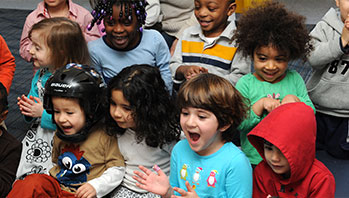- beans
- flowerpot or window box
- name cards
- sentence strips and chart
MA Standards:
English Language Arts/Speaking and Listening/SL.PK.MA.1a: Observe and use appropriate ways of interacting in a group (e.g. taking turns in talking, listening to peers, waiting to speak until another person is finished talking, asking questions and waiting for an answer, gaining the floor in appropriate ways).
English Language Arts/Foundational Skills/RF.PK.MA.3.c: Recognize one’s own name and familiar common signs and labels (e.g., STOP).
Head Start Outcomes:
Social Emotional Development/Self-Regulation: Follows simple rules, routines, and directions.
Language Development/Receptive Language: Attends to language during conversations, songs, stories, or other learning experiences.
Language Development/Receptive Language: Comprehends different grammatical structures or rules for using language.
Literacy Knowledge/Print Concepts and Conventions: Recognizes print in everyday life, such as numbers, letters, one’s name, words, and familiar logos and signs.
PreK Learning Guidelines:
English Language Arts/Language 1: Observe and use appropriate ways of interacting in a group (taking turns in talking; listening to peers; waiting until someone is finished; asking questions and waiting for an answer; gaining the floor in appropriate ways).
English Language Arts/Reading and Literature 12: Listen to, recite, sing, and dramatize a variety of age-appropriate literature.
Greeting Song “Where Is?” #15

© Commonwealth of Massachusetts, Department of Early Education and Care (Jennifer Waddell photographer). All rights reserved.
ELA Focus Skills: Name Recognition, Follow Directions, Phonological Awareness (Rhythm and Repetition)
Educator Prep: Fill the flowerpot or window box with beans and half-bury the name cards in the beans.
Tell children you are going to sing “Where Is?” again, but this time you are going to sing to two children at the same time. Explain that you want children to sing the third and fourth lines together.
- Say, When you answer, I want you to sing “Here we are! Here we are!”
- Explain that “I am” means there is just one person answering.
- Ask, Why do you think I want you to say “We are?” Explain if children are not able to respond. Say, “We” means more than one person is answering.
Hold up the window box full of name cards, pick two name cards, and place them in the chart. Have the two children stand slowly, as if growing, and sing their responses. Continue picking pairs of cards until all name cards have been picked.
Where Is?
(sung to the tune of “Where is Thumbkin?”)
(Educator:)
Where is <name of one child>? (Hold up one child’s name card)
Where is <name of the second child>? (Hold up the second child’s name card)
(Children stand up and sing:)
Here we are!
Here we are!
(Educator:)
How are you today, <name of one child>?
How are you today, <name of the second child>?
(Children:)
Very well, thank you!
Very well, thank you!
(Educator:)
Please sit down.
Please sit down.
Adaptation: For groups with very young children or children who do not yet recognize their name in print, you might want to give them direct acknowledgement before you sing the song to them. For example, say, Get ready Tamara, we will be singing to you next.
Adaptation: if you have an uneven number of children in your class, pick one name card two times or pull the name of an assistant or other adult in the class.
Social Emotional Tip: Changing procedures with greeting songs helps children gain the ability to manage transitions and adapt to changes in routines and new situations.
